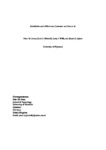Similarities and differences: Comment on Chan et al.
| dc.contributor.author | Jones, Peter M | |
| dc.contributor.author | Mitchell, Chris | |
| dc.contributor.author | Wills, Andy | |
| dc.contributor.author | Spicer, Stuart Gordon | |
| dc.contributor.other | Faculty of Health & Human Sciences | en_US |
| dc.date.accessioned | 2021-02-23T18:02:02Z | |
| dc.date.available | 2021-02-23T18:02:02Z | |
| dc.date.issued | 2021 | |
| dc.identifier.uri | http://hdl.handle.net/10026.1/16905 | |
| dc.description.abstract |
Spicer et al. (2020) reported a series of causal learning experiments in which participants appeared to learn most readily about cues when they were not certain of their causal status, and proposed that their results were a consequence of participants’ use of “theory protection”. In the present issue Chan et al. present an alternative view, using a modification of Rescorla and Wagner’s (1972) influential model of learning. Although the explanation offered by Chan et al. appears very different to that suggested by Spicer et al., there are conceptual commonalities. Here we briefly discuss the similarities and differences of the two approaches, and agree with Chan et al.’s proposal that the best way to advance the debate will be to test situations in which the two theories make differing predictions. | en_US |
| dc.language.iso | en | |
| dc.publisher | University of Plymouth | en |
| dc.rights | Attribution-NonCommercial-NoDerivs 3.0 United States | * |
| dc.rights.uri | http://creativecommons.org/licenses/by-nc-nd/3.0/us/ | * |
| dc.subject | associative learning | en_US |
| dc.subject | theory protection | en_US |
| dc.subject | learning models | en_US |
| dc.subject | causal learning | en_US |
| dc.subject | conditioning | en_US |
| dc.title | Similarities and differences: Comment on Chan et al. | en_US |
| dc.type | Article | en_US |



